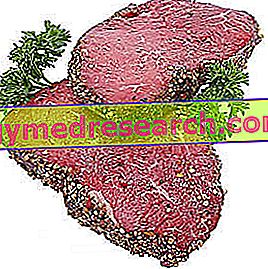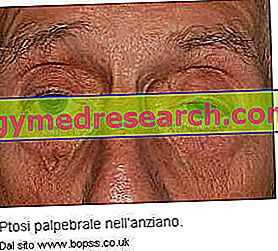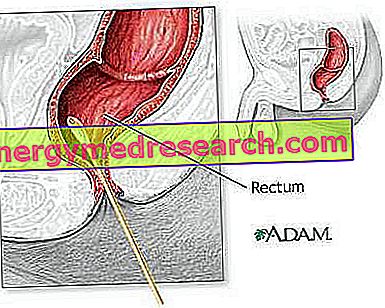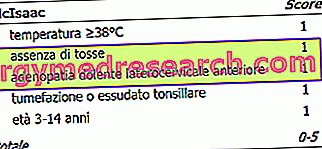The dangers caused by excess red meat in the diet are directly proportional to the abuse of its consumption.
A frequency of two or three portions of meat per week does not seem to contribute to the pathogenesis of any disease, provided that the entire diet is balanced and the cooking methods are suitable.
Cardiovascular diseases

Although with a certain variability in the sources consulted, beef, cow, bull, sheep, horse, mutton, buffalo and adult pork belong to the category of red meat.
The percentage of saturated fats varies not only according to the animal species, but also and above all based on the cut of meat.
Animal products, therefore also red meat, are foods that contain saturated lipids and bring more or less important quantities (depending on the cut and portion) of exogenous cholesterol. Therefore, the first danger referred to by the abuse of red meat is the alteration of lipidemia.
An excessive intake of dietary cholesterol and saturated fatty acids can cause (especially in sedentary and predisposed subjects) a direct and indirect rise in total cholesterol and especially LDL lipoproteins. The result is an increased cardiovascular risk due to the formation of atherosclerotic plaques that end up occluding the blood vessels.
Osteoporosis
Red meat brings a considerable amount of animal protein and from each portion (200-300g) it derives about 40-60g. The abuse of the consumption of animal proteins carries a rather important risk of developing a reduction in the metabolic efficiency of calcium. Therefore, if introduced in excess, animal proteins could favor the onset of a bone disease called osteoporosis. However, not all authors agree that the high-protein diet is a risk factor for osteoporosis, as it increases the urinary excretion of calcium and has a positive effect on intestinal absorption; it would also seem to stimulate the secretion of osteo-anabolic hormones, such as IGF-1. In any case, hypercalciuria associated with high-protein diets can be effectively compensated for by the simultaneous and generous intake of alkalizing foods (fresh fruit and vegetables).
Renal Distress
The increase in the amino acid supply deriving from animal proteins also determines the increase in azotemia levels, since the amino acids that are not used in anabolic processes constitute a substrate for neoglucogenetic and liposynthetic transformation.
This occurs in hepatocytes (liver cells) after deamination (deprivation of the amino group) of the nitrogen groups from the carbon skeleton. The catabolites, which are predominantly made up of ammonium, need a final conversion to urea to be expelled with urine.
The excess protein in the diet favors the accumulation of urea, causing a continuous and persistent renal fatigue. According to many studies, this condition could induce serious disorders such as chronic nephritis.
Gout
As if that were not enough, red meat is one of the foods that brings the greatest quantity of purines; these derive from the digestive catabolism of nucleic acids, which due to metabolization favor hyperuricemia. Simply put, the risk of hyperuricemia (gout) and related osteo-articular complications (sediment and crystal precipitation) and kidney (calculosis) are also present among the dangers of red dog excess.
Gastritis and Reflux
The digestion of red meat considerably commits the stomach which secretes large quantities of hydrochloric acid (HCl). The lowering of the pH is fundamental for the correct protein denaturation and for the pepsinogen activation in pepsin; however, a large protein content determines the slowing down of chyme travel times, due to the long stay in the gastric tract. In subjects who abuse red meat, especially cooked over a long period and in the evening, gastric and duodenal acidosis increases the risk of incidence of gastritis, ulcers and stomach cancer.
For the same reason, in subjects predisposed or suffering from incontinence of the lower gastro-esophageal sphincter, there is an increase in the incidence of gastric reflux which, in the long term, causes esophagitis, Barrett's esophagus and probably esophageal cancer.
Red Meat and Tumors
Regardless of the amount of protein, the excessive consumption of red meat also favors the indirect increase of some dangers inherent in the neoplastic (tumor) incidence of the stomach and intestines.
The residues of nitrites used in agriculture and those added for preservative purposes in processed meats are combined with food amines forming nitrosamines. The high and frequent consumption of sausages containing nitrates and nitrites determines the increase of the combination in nitrosamines, which possess a very high carcinogenic power in the stomach.
2015 - The blunder of newspapers
In October 2015, the International Agency for Research on Cancer (IARC), part of the WHO (World Health Organization), included WORKED meats among the substances that can cause cancer in men.
This news, which has been given ample media coverage, has caused excessive and unjustified alarmism in the population, aided by gross and misleading information .
Let us therefore clarify some fundamental aspects present in the scientific publication related to this event.
What Tumors?
- First of all, the report was epidemiologically ascertained "only" for colorectal cancer, which in Italy represents about 13-14% of all registered cancer cases, ranking third for incidence in men and in second place in women .
- A less certain link has instead been identified with stomach cancer, which in Italy represents about 5% of all recorded cases of cancer.
We are therefore talking about a relationship that DOES NOT CONCERGE ALL KINDS OF CANCER, BUT ONLY COLON CANCER and probably stomach cancer.
What Meats?
Another very important aspect concerns the quality of the meat, since the study explicitly mentions:
- WORKED meats, ie salted, dried, fermented, smoked meats, treated with preservatives to improve their flavor or preservation.
So we are not talking about fresh meat, but preserved meat (in other words cured meats, especially smoked meats, canned meats and meat-based sauces).
With all due respect to vegans, the relationship between meat and colon cancer is not certain for the classic "grilled" Florentine and other fresh red meats, but ONLY for SALUMI, WURSTEL, SMOKED MEAT and generally preserved.
Therefore, the study does not discover anything new, given that for years the dangerousness of the preservatives used in processed meats (in particular nitrates and even more nitrites) is known.
Fresh red MEAT
With regard to fresh red meat (beef, lamb and pork), the study classifies them as " probably carcinogenic " in reference to three specific types of cancer: the colon, the prostate and the stomach.
To get a correct view, the statistics should still be differentiated by type and cut of meat; probably, for example, the oncogenic risk is significant for those who consume 200 grams of pork sausages a day, while it is not for those who consume similar quantities of beef fillet.
Pay attention to the Cooking Mode
As for fresh meats, we remind you that the high temperature cooking mode generates toxic and carcinogenic substances.
Lean fresh meat does not appear to be carcinogenic and this is all the more true when cooking is more sober; to be clear, you should avoid burning parts of the food, giving up the classic "black stripes" left by the embers and the grill pan.
Relationship with Other Risk Factors
It is logical to expect that the consumption of preserved meat is more common among the population groups that are generally less attentive to food and health.
Conversely, the attention towards one's health is generally greater among vegetarians and vegans; in this group, it is therefore logical to expect fewer percentages of smokers, alcoholics and overweight people, greater attention to physical activity and a greater supply of antioxidants, dietary fiber and other protective colon cancer colonies, to the stomach and prostate.
A serious and reliable comparison should therefore be carried out between two populations with the same risk factors, with the exception of what one intends to evaluate.
Considering only the nutritional aspect or further reducing the comparison to a single group of foods leads to big blunders.
This has led many experts to oversize the alleged benefits of a vegetarian or vegan diet as an element of cancer prevention.
Importance of Cooking
The dangers of excessive consumption of red meat also include those linked to the formation of toxic compounds deriving from the carbonization of proteins.
Particularly rapid and intense cooking (grill and plate) favor the production of highly toxic and carcinogenic compounds: polycyclic aromatic hydrocarbons, of which the most harmful is undoubtedly benzopyrene. Those resulting from the diet mainly affect the stomach, intestines, liver and bladder.
Dysbiosis
The alteration of the intestinal bacterial flora is less incisive on healthy subjects, but decisive in geriatric patients. In the third age, albeit rare, the abuse of meat consumption at the expense of foods containing dietary fiber favors fecal stagnation (for constipation) and predisposes the development of pathogenic microorganisms within the intestinal lumen. These saprophytic colonies determine the lowering of the pH, the fecal putrefaction and the accumulation of toxins, reducing the physiological bacterial flora to the detriment of its functions (immune and vitamin synthesis: vit K, vit PP and small amounts of vit B12.
Bibliography
- Amanda J Cross, Neal D Freedman, Jiansong Ren, Mary H Ward, Albert R Hollenbeck, Arthur Schatzkin, Rashmi Sinha and Christian C Abnet - Meat Consumption and Risk of Esophageal and Gastric Cancer in a Large Prospective Study ( American Journal of Gastroenterology, ( 26 October 2010) | doi: 10.1038 / ajg.2010.415
- Zemel MB - Calcium utilization: Effect of varying level and source of dietary protein - American Journal of Clinical Nutrition - (1988) 48: 880-883.
- LH Newburgh, MD - Hight protein diets and nephritis - In The Journal, January 10, p. 107
- Diseases of the heart. Treatise on cardiovascular medicine. Seventh edition - DP Zipes, P. Libby, RO Bonow, E. Braunwald - chapter 41
- Reasoned medical therapy. - A. Zangara - Piccin - pag 564-565
- Diseases of the esophagus. Diagnosis and therapy - A. Battocchia, E. Laterza - Piccin - chapter 19; pag 197: 202
- Alan Moss MBBS (Hons), FRACP, Michael J Bourke MBBS, FRACP, Luke F Hourigan MBBS, FRACP, Saurabh Gupta MBBS, FRACP, Stephen J Williams MBBS, MD, FRACP, Kayla Tran MBBS, FRCP, Michael P Swan MBBS, FRACP, Andrew D Hopper MRCP, MD, Vu Kwan MBBS, FRACP and Adam A Bailey MBChB, FRACP - Endoscopic Resection for Barrett's High-Grade Dysplasia and Early Esophageal Adenocarcinoma: An Essential Staging Procedure With Long-Term Therapeutic Benefit - Am J Gastroenterol 105: 1276-1283; advance online publication, February 23, 2010; doi: 10.1038 / ajg.2010.1
- Rashmi Sinha, PhD; Amanda J. Cross, PhD; Barry I. Graubard, PhD; Michael F. Leitzmann, MD, DrPH; Arthur Schatzkin, MD, DrPH - Meat Intake and Mortality. A Prospective Study of Over Half at Million People - Arch Intern Med. 2009; 169 (6): 562-571.
- E. Giovannucci et al. - Intake of fat, meat, and fiber in relation to risk of colon cancer in men - Cancer Research - 54: pp. 2390-2397, 1994.



